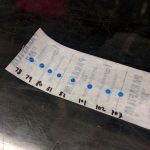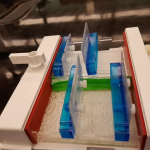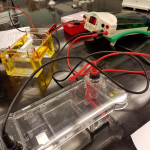(This blog post was prepared by students enrolled in the Koala Poop Microbiome Class in the Fall of 2016 at UC Davis)

The original goal of this week was to perform DNA clean up via a PCR clean-up kit, but unfortunately the kits were on backorder. Thus, the focus of the class shifted to gel electrophoresis. It had turned out that the DNA samples from the previous week had undergone a different programing, therefore all the samples had to be redone using the proper PCR programming. These were conducted by the instructional assistants. By doing gel electrophoresis, we were able to see how many of the samples were amplified properly the second time around.

We began the lab by creating the agarose gels in 5 groups of 4. This process was somewhat challenging since there were limited resources and the molds for the gels were not the same exact size as the actual electrophoresis gel boxes. While the gels were cooling, we prepared our individual samples for loading by adding the loading dye on a sheet of parafilm. We then carefully loaded the samples into the wells of the gel, making sure the gels were intact and unpunctured. Some of the gels had to have two sets of wells since there were not enough materials. Some of the gels were not run fully but partially, and were stopped before the samples of the top row ran into the wells of the second row. We did this in order to ensure clear readings of the bands when brought under a UV light. The gels were then transferred to the UV box for analysis. Based on observations, very little samples demonstrated strong and weak bands, while others showed nothing. It was interesting to finally be able to visualize the DNA samples, and know that the work we had done extracting it from the bacteria was successful in some of them.
(Fun Fact: Gel electrophoresis was created over 60 years ago by Oliver Smithies, and is still commonly used in medical and criminal sciences)

The class over the past few weeks has been interesting but at times frustrating due to the lack of resources/funding. This has also made it very challenging, however allows us to critically think and come up with different solutions in order to make the limited amount of resources work. So how does the scientific community handle these types of issues when there seems to be too many people and not enough materials?